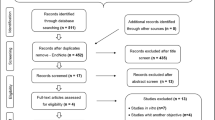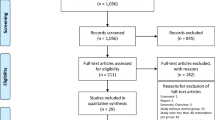Abstract
AIM: To determine whether resin-modified glass-ionomer cement (RM-GIC), when compared with composite resins (CR), offers a significant caries-preventive effect. STUDY DESIGN: Quantitative systematic review. METHODS: Five databases were searched until 29 July 2010. Inclusion criteria were: relevant to review question related to orthodontic or restorative treatment; published in English; prospective clinical 2-arm study. Exclusion criteria were: no computable data reported; study groups not followed up in the same way. References of included articles were checked. The outcome measure was absence of carious lesions. Dichotomous datasets for both groups were extracted from accepted trials. Trials were assessed for selection-, detection/performance, attrition and publication bias. RESULTS: Of the 11 trials included, 6 were accepted and 24 datasets extracted; 17 datasets showed no difference after 4 weeks to >25 months. There were 7 datasets that favoured (p < 0.05) RM-GIC after 12 — 24 months. The results are limited by risk of selection-, detection-/performance bias and attrition bias. Risk of publication bias was identified. CONCLUSIONS: The overall results showed either no difference between the materials, or indicated that RM-GIC has a superior caries-preventive effect. The clinical meaning of this result remains uncertain due to risk of bias. High-quality randomised control trials are needed in order to answer the review question conclusively.
Similar content being viewed by others
References
Andersson-Wenckert I, Sunnegårdh-Grönberg K. Flowable resin composite as a class II restorative in primary molars: A two-year clinical evaluation. Acta Odontol Scand 2006; 64:334–340.
Bax L, Yu LM, Ikeda N, Tsuruta H, Moons KGM. Development and validation of MIX: comprehensive free software for meta-analysis of causal research data. BMC Med Res Methodol 2006; 6: 50.
Berger VW. Selection bias and covariate imbalances in randomised clinical trials. Chichester: John Wiley & Sons, Ltd., 2005.
Berger VW, Alperson SY. A general framework for the evaluation of clinical trial quality. Rev Recent Clin Trials 2009; 4: 79–88.
Burgess JO, Gallo JR, Ripps AH, Walker RS, Ireland EJ. Clinical evaluation of four Class 5 restorative materials: 3-year recall. Am J Dent 2004; 17: 147–150.
Chalmers TC, Matta RJ, Smith H Jr, Kunzler AM. Evidence favoring the use of anticoagulants in the hospital phase of acute myocardial infarction. N Engl J Med 1977; 297:1091–1096.
Chung CK, Millett DT, Creanor SL, Gilmour WH, Foye RH. Fluoride release and cariostatic ability of a compomer and a resin-modified glass ionomer cement used for orthodontic bonding. J Dent 1998; 26:533–538.
Donly KJ, Segura A, Wefel JS, Hogan MM. Evaluating the effects of fluoride-releasing dental materials on adjacent interproximal caries. J Am Dent Assoc 1999; 130:817–825.
Egger M, Davey Smith G, Schneider M, Minder C. Bias in meta-analysis detected by a simple, graphical test. BMJ 1997; 315: 629–634.
Egger M, Jüni P, Bartlett C, Holenstein F, Sterne J. How important are comprehensive literature searches and the assessment of trial quality in systematic reviews? Empirical study. Health Technol Assess 2003; 7:1–76.
Ewoldsen N, Herwig L. Decay-inhibiting restorative materials: past and present. Compend Contin Educ Dent 1998; 19: 981–986.
Fuks AB, Araujo FB, Osorio LB, Hadani PE, Pinto AS. Clinical and radiographic assessment of Class II esthetic restorations in primary molars. Pediatr Dent 2000; 22: 479–485.
Gaworski M, Weinstein M, Borislow AJ, Braitman LE. Decalcification and bond failure: A comparison of a glass ionomer and a composite resin bonding system in vivo. Am J Orthod Dentofacial Orthop 1999; 116:518–521.
Higgins JPT, Green S. Cochrane handbook for systematic reviews of interventions 4.2.6. In: The Cochrane Library, Issue 4. Chichester: John Wiley & Sons, Ltd.; 2006:82:113–114.
Jang KT, Garcia-Godoy F, Donly KJ, Segura A. Remineralizing effects of glass ionomer restorations on adjacent interproximal caries. ASDC J Dent Child 2001; 68:125–128.
Kilpatrick NM, Murray JJ, McCabe JF. A clinical comparison of a light cured glass ionomer sealant restoration with a composite sealant restoration. J Dent 1996; 24: 399–405.
Kjaergard LL, Villumsen J, Gluud C. Reported Methodological quality and discrepancies between large and small randomised trials in meta-Analyses. Ann Intern Med 2001; 135: 982–989.
Kotsanos N, Dionysopoulos P. Lack of effect of fluoride releasing resin modified glass ionomer restorations on the contacting surface of adjacent primary molars. a clinical prospective study. Eur J Paediatr Dent 2004; 5:136–142.
Lesaffre E, Garcia Zattera MJ, Redmond C, Huber H, Needleman I. Reported methodological quality of split-mouth studies. J Clin Periodontol 2007; 34: 756–61.
McComb D, Erickson RL, Maxymiw WG, Wood RE. A clinical comparison of glass ionomer, resin-modified glass ionomer and resin composite restorations in the treatment of cervical caries in xerostomic head and neck radiation patients. Oper Dent 2002; 27:430–437.
McDonagh MS, Whiting PF, Wilson PM, et al. Systematic review of water fluoridation. BMJ 2000; 321:855–859.
Mejáre I, Lingström P, Petersson LG, et al. Caries-preventive effect of fissure sealants: a systematic review. Acta Odontol Scand 2003; 61:321–330.
Mickenautsch S. Systematic reviews, systematic error and the acquisition of clinical knowledge. BMC Med Res Methodol 2010; 10:53.
Mickenautsch S, Yengopal V, Leal SC, Oliveira LB, Bezerra AC, Bönecker M. Absence of carious lesions at margins of glass-ionomer and amalgam restorations: a meta-analysis. Eur Archs Paediatr Dent 2009; 10:41–46.
Moher D, Schulz KF, Altman DG. The CONSORT statement: revised recommendations for improving the quality of reports of parallel — group randomised trials. Lancet 2001; 357:1191–1194.
Mjör IA, Toffenetti F. Secondary caries: A literature review with case reports. Quintessence Int 2000; 31:165–179.
Nagamine M, Itota T, Torii Y, Irie M, Staninec M, Inoue K. Effect of resinmodified glass ionomer cements on secondary caries. Am J Dent 1997; 10:173–178.
Okida RC, Mandarino F, Sundfeld RH, de Alexandre RS, Sundefeld ML. In vitro-evaluation of secondary caries formation around restoration. Bull Tokyo Dent Coll 2008; 49:121–128.
Paradella TC, Koga-Ito CY, Jorge AO. Ability of different restorative materials to prevent in situ secondary caries: analysis by polarized light-microscopy and energy-dispersive X-ray. Eur J Oral Sci 2008; 116:375–380.
Park SH, Kim KY. The anticariogenic effect of fluoride in primer, bonding agent, and composite resin in the cavosurface enamel area. Oper Dent 1997; 22:115–120.
Rothstein HR, Sutton AJ, Borenstein M. Publication bias in meta-analysis. In: Publication bias in meta-analysis — prevention, assessment and adjustment. Chichester: John Wiley & Sons, Ltd.; 2005a: 1–7.
Rothstein HR, Sutton AJ, Borenstein M. Software for publication bias. In: Publication bias in meta-analysis — prevention, assessment and adjustment. Chichester: John Wiley & Sons, Ltd.; 2005b: 193–220.
Takeuti ML, Marquezan M, Rodrigues CR, Rodrigues Filho LE, Rocha Rde O. Inhibition of demineralisation adjacent to tooth-colored restorations in primary teeth after 2 in vitro challenges. J Dent Child (Chic) 2007; 74: 209–214.
Tantbirojin D, Douglas WH, Verslius A. Inhibitive effect of a resin modified glass ionomer cement on remote artificial caries. Caries Res 1997; 31:275–280.
Torii Y, Itota T, Okamoto M, Nakabo S, Nagamine M, Inoue K. Inhibition of artificial secondary caries in root by fluoride-releasing restorative materials. Oper Dent 2001; 26: 36–43.
Twetman S, Axelsson S, Dahlgren H, et al. Caries-preventive effect of fluoride toothpaste: a systematic review. Acta Odontol Scand 2003; 61:347–355.
van Dijken JW. Durability of new restorative materials in Class III cavities. J Adhes Dent 2001; 3: 65–70.
Wiegand A, Buchalla W, Attin T. Review on fluoride-releasing restorative materials-fluoride release and uptake characteristics, antibacterial activity and influence on caries formation. Dent Mater 2007; 23:343–362.
Wilson RM, Donly KJ. Demineralisation around orthodontic brackets bonded with resin-modified glass ionomer cement and fluoride-releasing resin composite. Pediatr Dent 2001; 23:255–259.
Yengopal V, Mickenautsch S. Resin-modified glass-ionomer cements versus resin-based materials as fissure sealants: a meta-analysis of clinical trials. Eur Arch Paediatr Dent 2010; 11:18–25.
Author information
Authors and Affiliations
Corresponding author
Rights and permissions
About this article
Cite this article
Yengopal, V., Mickenautsch, S. Caries-preventive effect of resin-modified glass-ionomer cement (Rm-GIC) versus composite resin: a quantitative systematic review. Eur Arch Paediatr Dent 12, 5–14 (2011). https://doi.org/10.1007/BF03262772
Published:
Issue Date:
DOI: https://doi.org/10.1007/BF03262772




